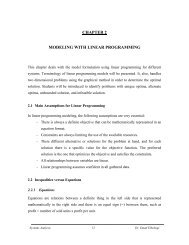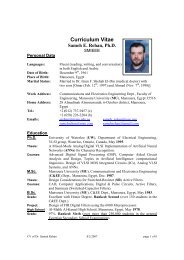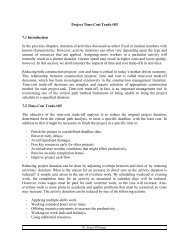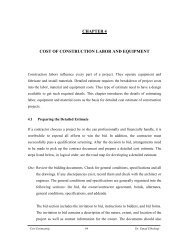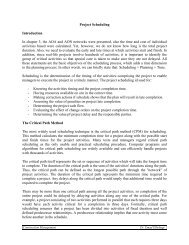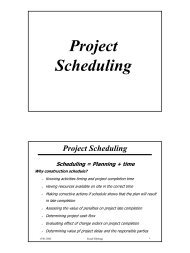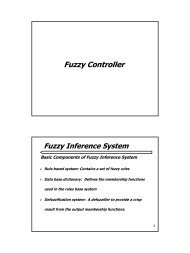CHAPTER 8 PROJECT TIME-COST TRADE-OFF
CHAPTER 8 PROJECT TIME-COST TRADE-OFF
CHAPTER 8 PROJECT TIME-COST TRADE-OFF
Create successful ePaper yourself
Turn your PDF publications into a flip-book with our unique Google optimized e-Paper software.
<strong>CHAPTER</strong> 8<strong>PROJECT</strong> <strong>TIME</strong>-<strong>COST</strong> <strong>TRADE</strong>-<strong>OFF</strong>In the previous chapters, duration of activities discussed as either fixed or randomnumbers with known characteristics. However, activity durations can often varydepending upon the type and amount of resources that are applied. Assigning moreworkers to a particular activity will normally result in a shorter duration. Greater speedmay result in higher costs and lower quality, however. In this section, we shall considerthe impacts of time and cost trade-offs in activities.Reducing both construction projects’ cost and time is critical in today’s market-driveneconomy. This relationship between construction projects’ time and cost is called timecosttrade-off decisions, which has been investigated extensively in the constructionmanagement literature. Time-cost trade-off decisions are complex and require selectionof appropriate construction method for each project task. Time-cost trade-off, in fact, isan important management tool fo overcoming one of the critical path method limitationsof being unable to bring the project schedule to a specified duration.8.1 Time-Cost Trade-OffThe objective of the time-cost trade-off analysis is to reduce the original project duration,determined form the critical path analysis, to meet a specific deadline, with the least cost.In addition to that it might be necessary to finish the project in a specific time to:- Finish the project in a predefined deadline date.- Recover early delays.- Avoid liquidated damages.- Free key resources early for other projects.Construction Management 164 Dr. Emad Elbeltagi
- Avoid adverse weather conditions that might affect productivity.- Receive an early completion-bonus.- Improve project cash flowReducing project duration can be done by adjusting overlaps between activities or byreducing activities’ duration. What is the reason for an increase in direct cost as theactivity duration is reduced? A simple case arises in the use of overtime work. Byscheduling weekend or evening work, the completion time for an activity as measured incalendar days will be reduced. However, extra wages must be paid for such overtimework, so the cost will increase. Also, overtime work is more prone to accidents andquality problems that must be corrected, so costs may increase. The activity duration canbe reduced by one of the following actions:- Applying multiple-shifts work.- Working extended hours (over time).- Offering incentive payments to increase the productivity.- Working on week ends and holidays.- Using additional resources.- Using materials with faster installation methods.- Using alternate construction methods or sequence.8.2 Activity Time-Cost RelationshipIn general, there is a trade-off between the time and the direct cost to complete anactivity; the less expensive the resources, the larger duration they take to complete anactivity. Shortening the duration on an activity will normally increase its direct costwhich comprises: the cost of labor, equipment, and material. It should never be assumedthat the quantity of resources deployed and the task duration are inversely related. Thusone should never automatically assume that the work that can be done by one man in 16weeks can actually be done by 16 men in one week.Construction Management 165 Dr. Emad Elbeltagi
A simple representation of the possible relationship between the duration of an activityand its direct costs appears in Figure 8.1. Considering only this activity in isolation andwithout reference to the project completion deadline, a manager would choose a durationwhich implies minimum direct cost, called the normal duration. At the other extreme, amanager might choose to complete the activity in the minimum possible time, calledcrashed duration, but at a maximum cost.CostCrash duration&Crash costNormal duration&Normal costFigure 8.1: Illustration of linear time/cost trade-off for an activityThe linear relationship shown in the Figure 8.1 between these two points implies that anyintermediate duration could also be chosen. It is possible that some intermediate pointmay represent the ideal or optimal trade-off between time and cost for this activity. Theslope of the line connecting the normal point (lower point) and the crash point (upperpoint) is called the cost slope of the activity. The slope of this line can be calculatedmathematically by knowing the coordinates of the normal and crash points.TimeCost slope = crash cost – normal cost / normal duration – crash durationAs shown in Figures 8.1, 8.2, and 8.3, the least direct cost required to complete anactivity is called the normal cost (minimum cost), and the corresponding duration iscalled the normal duration. The shortest possible duration required for completing theactivity is called the crash duration, and the corresponding cost is called the crash cost.Normally, a planner start his/her estimation and scheduling process by assuming the leastcostly optionConstruction Management 166 Dr. Emad Elbeltagi
CostCrash duration&Crash costNormal duration&Normal costTimeFigure 8.2: Illustration of non-linear time/cost trade-off for an activityCostCrash duration&Crash costNormal duration&Normal costTimeFigure 8.3: Illustration of discrete time/cost trade-off for an activityExample 8.1A subcontractor has the task of erecting 8400 square meter of metal scaffolds. Thecontractor can use several crews with various costs. It is expected that the production willvary with the crew size as given below:Construction Management 167 Dr. Emad Elbeltagi
Estimated daily production(square meter)166204230Crewsize(men)567Crew formation1 scaffold set, 2 labors, 2 carpenter, 1 foreman2 scaffold set, 3 labors, 2 carpenter, 1 foreman2 scaffold set, 3 labors, 3 carpenter, 1 foremanConsider the following rates: Labor LE96/day; carpenter LE128/day; foreman LE144/dayand scaffolding LE60/day. Determine the direct cost of this activity considering differentcrews formation.SolutionThe duration for installing the metal scaffold can be determined by dividing the totalquantity by the estimated daily production. The cost can be determined by summing upthe daily cost of each crew and then multiply it by the duration of using that crew. Thecalculations are shown in the following table.Crew size Duration (days) Cost (LE)56750.6 (use 51)41.2 (use 42)36.5 (use 37)51 x (1x60 + 2x96 + 2x128 + 1x144) = 3325242 x (2x60 + 3x96 + 2x128 + 1x144) = 3393637 x (2x60 + 3x96 + 3x128 + 1x144) = 34632This example illustrates the options which the planner develops as he/she establishes thenormal duration for an activity by choosing the least cost alternative. The time-costrelationship for this example is shown in Figure 8.4. The cost slop for this activity can becalculates as follow:Cost slope 1 (between points 1 and 2) = (33936 – 33252) / (51 – 42) = 76.22 LE/dayCost slope 2 (between points 2 and 3) = (34632 – 33936) / (42 – 37) = 139.2 LE/dayConstruction Management 168 Dr. Emad Elbeltagi
Cost (LE)3480034600344003420034000338003360033400332003300032130 35 40 45 50 55Duration (days)8.3 Project Time-Cost RelationshipFigure 8.4: Time-cost relationship of Example 8.1Total project costs include both direct costs and indirect costs of performing the activitiesof the project. Direct costs for the project include the costs of materials, labor, equipment,and subcontractors. Indirect costs, on the other hand, are the necessary costs of doingwork which can not be related to a particular activity, and in some cases can not berelated to a specific project.If each activity was scheduled for the duration that resulted in the minimum direct cost inthis way, the time to complete the entire project might be too long and substantialpenalties associated with the late project completion might be incurred. Thus, plannersperform what is called time-cost trade-off analysis to shorten the project duration. Thiscan be done by selecting some activities on the critical path to shorten their duration.As the direct cost for the project equals the sum of the direct costs of its activities, thenthe project direct cost will increase by decreasing its duration. On the other hand, theindirect cost will decrease by decreasing the project duration, as the indirect cost arealmost a linear function with the project duration. Figure 8.5 illustrates the direct andindirect cost relationships with the project duration.Construction Management 169 Dr. Emad Elbeltagi
Project costProject durationFigure 8.5: Project time-cost relationshipThe project total time-cost relationship can be determined by adding up the direct costand indirect cost values together as shown in Figure 8.5. The optimum project durationcan be determined as the project duration that results in the least project total cost.8.4 Shortening Project DurationThe minimum time to complete a project is called the project-crash time. This minimumcompletion time can be found by applying critical path scheduling with all activitydurations set to their minimum values. This minimum completion time for the project canthen be used to determine the project-crash cost. Since there are some activities not on thecritical path that can be assigned longer duration without delaying the project, it isadvantageous to change the all-crash schedule and thereby reduce costs.Heuristic approaches are used to solve the time/cost tradeoff problem such as the costlopemethod used in this chapter. In particular, a simple approach is to first apply criticalpath scheduling with all activity durations assumed to be at minimum cost. Next, theplanner can examine activities on the critical path and reduce the scheduled duration ofactivities which have the lowest resulting increase in costs. In essence, the plannerdevelops a list of activities on the critical path ranked with their cost slopes. The heuristicsolution proceeds by shortening activities in the order of their lowest cost slopes. As theConstruction Management 170 Dr. Emad Elbeltagi
duration of activities on the shortest path are shortened, the project duration is alsoreduced. Eventually, another path becomes critical, and a new list of activities on thecritical path must be prepared. Using this way, good but not necessarily optimalschedules can be identified.The procedure for shortening project duration can be summarized in the following steps:1. Draw the project network.2. Perform CPM calculations and identify the critical path, use normal durations andcosts for all activities.3. Compute the cost slope for each activity from the following equation:cost slope = crash cost – normal cost / normal duration – crash duration4. Start by shortening the activity duration on the critical path which has the least costslope and not been shortened to its crash duration.5. Reduce the duration of the critical activities with least cost slope until its crashduration is reached or until the critical path changes.6. When multiple critical paths are involved, the activity(ies) to shorten is determinedby comparing the cost slope of the activity which lies on all critical paths (if any),with the sum of cost slope for a group of activities, each one of them lies on one ofthe critical paths.7. Having shortened a critical path, you should adjust activities timings, and floats.8. The cost increase due to activity shortening is calculated as the cost slopemultiplied by the time of time units shortened.9. Continue until no further shortening is possible, and then the crash point is reached.10. The results may be represented graphically by plotting project completion timeagainst cumulative cost increase. This is the project direct-cost / time relationship.By adding the project indirect cost to this curve to obtain the project time / costcurve. This curve gives the optimum duration and the corresponding minimumcost.Construction Management 171 Dr. Emad Elbeltagi
Example 8.2Assume the following project data given in Table 8.1. It is required to crash the projectduration from its original duration to a final duration of 110 days. Assume daily indirectcost of LE 100.Table 8.1: Data for Example 8.2ActivityPreceded byNormalCrashDuration (day) Cost (LE) Duration (day) Cost (LE)A-1201200010014000B-201800152800CB40160003022000DC301400202000ED, F503600404800FB60135004518000SolutionThe cost slope of each activity is calculated. Both the crashability and the cost slope areshown beneath each activity in the precedence diagram. The critical path is B-C-D-E andthe project duration in 140 days. Project total normal direct cost = sum of normal directcosts of all activities = LE 48300.0 120A (120)20 140140 140End (0)140 1400 0Start (0)0 020@10020 60C (40)20 6060 90D (30)60 9090 140E (50)90 14010@60010@6010@1200 20B (20)0 2020 80F (60)30 905@20015@3001. The activity on the critical path with the lowest cost slope is of activity “D”, thisactivity can be crashed by 10 days. Then adjust timing of the activities.Construction Management 172 Dr. Emad Elbeltagi
0 120A (120)10 130130 130End (0)130 1300 0Start (0)0 020@10020 60C (40)20 6060 80D (20)60 8080 130E (50)80 13010@60010@1200 20B (20)0 2020 80F (60)20 805@200 15@300A new critical path will be formed, B-F-E.New Project duration is 130 days.The project direct cost is increased by 10 x 60 = LE 600.Project direct cost = 48300 + 600 = LE 489002. At this step activity “E” will be crashed, as this activity lies on both critical paths.Activity “E” will be shortened by 10 days.0 120A (120)0 120120 120End (0)120 1200 0Start (0)0 020@10020 60C (40)20 6060 80D (20)60 8080 120E (40)80 12010@6000 20B (20)0 2020 80F (60)20 805@200 15@300Accordingly, all activities will b turn to critical activities.New Project duration is 120 days.The project direct cost is increased by 10 x 120 = LE 1200.Project direct cost = 48900 + 1200 = LE 50100Construction Management 173 Dr. Emad Elbeltagi
3. In this step, it is difficult to decrease one activity’s duration and achieve decreasing inthe project duration. So, either to crash an activity on all critical paths (if any),otherwise, choose several activities on different critical paths. As shown, activities“A” and “B” can be crashed together which have the least cost slope (100 + 200).Then, crash activities “A” and “B” by 5 days.0 115A (115)0 115115 115End (0)115 1150 0Start (0)0 015@10015 55C (40)15 5555 75D (20)55 7575 115E (40)75 11510@6000 15B (15)0 1515 75F (60)15 7515@300New Project duration is 115 days.The project direct cost is increased by 5 x (100 + 200) = LE 1500.Project direct cost = 50100 + 1500 = LE 516004. In this final step, it is required to decrease the duration of an activity from each path.The duration of activity ”A” will be crashed to 110 days, “C” to 35 days, and “F” to55 days. Thus, achieving decreasing project duration to 110 days. Also, increase inthe project direct cost by 5 x (100 + 600 + 300) = LE 50000 110A (110)0 110110 110End (0)110 1100 0Start (0)0 010@10015 50C (35)15 5050 70D (20)50 7070 110E (40)70 1105@6000 15B (15)0 1515 70F (55)15 7010@300Construction Management 174 Dr. Emad Elbeltagi
Duration (days) Direct cost (LE) Indirect cost (LE) Total cost (LE)140130120115110483004890050100516005660014000130001200011500110006230061900621006310067600800007000060000Cost (LE)5000040000300002000010000Example 8.30100 110 120 130 140 150Project duration (days)The durations and direct costs for each activity in the network of a small constructioncontract under both normal and crash conditions are given in the following table.Establish the least cost for expediting the contract. Determine the optimum duration ofthe contract assuming the indirect cost is LE 125/day.SolutionThe cost slope of each activity is calculated. Both the crashability and the cost slope areshown beneath each activity in the precedence diagram. The critical path is A-C-G-I andthe contract duration in 59 days.Construction Management 175 Dr. Emad Elbeltagi
Table 8.2: Data for Example 8.3ActivityPreceded byNormalCrashDuration (day) Cost (LE) Duration (day) Cost (LE)ABCDEFGHI-AABBCE, CFD, G, H128152355201312700050004000500010003000600025003000106122344151110720053004600500010503300630025803150SolutionThe cost slope of each activity is calculated. Both the crashability and the cost slope areshown beneath each activity in the precedence diagram. The critical path is A-C-G-I andthe contract duration in 59 days.20 43D (23)24 470 12 12 20 20 25A (12) B (8)E (5)0 12 14 22 22 272@100 2@150 1@5027 47G (20)27 475@6047 59I (12)47 592@7512 27C (15)12 273@20027 32F (5)29 341@30032 45H (13)34 472@401. The activity on the critical path with the lowest cost slope is “G”, this activity canbe crashed by 5 days, but if it is crashed by more than 2 days another critical pathwill be generated. Therefore, activity “G” will be crashed by 2 days only. Thenadjust timing of the activities.Construction Management 176 Dr. Emad Elbeltagi
20 43D (23)22 450 12 12 20 20 25A (12) B (8)E (5)0 12 14 22 22 272@100 2@150 1@5027 45G (18)27 453@6045 57I (12)45 572@7512 27C (15)12 273@20027 32F (5)27 321@30032 45H (13)32 452@40A new critical path will be formed, A-C-F-H-I.New contract duration is 57 days and the cost increase is 2 x 60 = LE 120.2. At this step the activities that can be crashed are listed below:Either “A” at cost LE 100/dayOr “C” at cost LE 200/dayOr “I” at cost LE 75/dayOr “F & G” at cost LE 360/dayOr “H & G” at cost LE 100/ dayActivity “I” is chosen because it has the least cost slope, and it can be crashed by 2days. Because it is last activity in the network, it has no effect on other activities.20 43D (23)22 450 12 12 20 20 25A (12) B (8)E (5)0 12 14 22 22 272@100 2@150 1@5027 45G (18)27 453@6045 55I (10)45 5512 27C (15)12 273@20027 32F (5)27 321@30032 45H (13)32 452@40New contract duration is 55 days and the cost increase is 2 x 75 = LE 150.Cumulative cost increase = 120 + 150 = LE 270Construction Management 177 Dr. Emad Elbeltagi
3. Now, we could select “A” or both “H & G”, because they have the same costslope. Activity “A” is chosen to be crashed. This will change the timings for allactivities, but no new critical path will be formed.18 41D (23)20 430 10A (10)0 1010 18B (8)12 202@15018 23E (5)20 251@5025 43G (18)25 433@6043 53I (10)43 5310 25C (15)10 253@20025 30F (5)25 301@30030 43H (13)30 432@40New contract duration is 53 days and the cost increase is 2 x 100 = LE 200.Accordingly, cumulative cost increase = 270 + 200 = LE 4704. Now, activities “H & G” can be crashed by 2 days each. “A” new critical path A-B-D-I will be formed.18 41D (23)18 410 10A (10)0 1010 18B (8)10 182@15018 23E (5)20 251@5025 41G (16)25 411@6041 51I (10)41 5110 25C (15)10 253@20025 30F (5)25 301@30030 41H (11)30 41New contract duration is 51 day and the cost increase is 2 x 100 = LE 200.Accordingly, cumulative cost increase = 470 + 200 = LE 670Construction Management 178 Dr. Emad Elbeltagi
5. At this stage, the network has three critical paths. The activities that can becrashed are listed below:Either C & B at cost LE 350/day or F, G & B at cost LE 510/dayActivities C & B are chosen because they have the least cost slope.16 39D (23)16 390 10A (10)0 1010 16B (6)10 1616 21E (5)18 231@5023 39G (16)23 391@6039 49I (10)39 4910 23C (13)10 31@20023 28F (5)23 281@30028 39H (11)28 39New contract duration is 49 days and the cost increase is 2 x 350 = LE 700.Cumulative cost increase = 670 + 700 = LE 1370Now, there is no further shortening is possible.The contract duration and the corresponding cost are given in the table below.Duration Direct cost X 1000 LE Indirect cost x 1000 LE Total cost x 1000 LE59 36.50 7.375 43.87557 36.62 7.125 43.74555 36.77 6.875 43.64553 36.97 6.625 43.59551 37.17 6.375 43.54549 37.87 6.125 43.995LE x 10005040302010Total costDirect costIndirect cost048 50 52 54 56 58 60Time (days)Construction Management 179 Dr. Emad Elbeltagi
8.5 Exercises1. The following table gives the activities involved in a pipeline contract. Theduration and cost data are also given. The indirect cost for the contract isLE120/day. Calculate the minimum cost of the work corresponding to contractduration of 102 days.Normal Crashability CostAct. Description Predes.SlopeTime Cost (days) (LE)A Preparation --- 10 200 - -B Move on to site A 20 200 - -C Obtain pipes A 40 1800 - -D Obtain valves A 28 500 8 10E Locate pipeline B 8 150 - -F Cut specials C 10 100 4 40G Excavate trench E 30 3000 20 180H Prepare valve chambers C, G 20 2800 12 50I Layout joint pipes C, G 24 1000 10 65J Fit valves D, F, H 10 200 4 80K Concrete anchors I 8 520 1 80L Backfill J, K 6 420 1 60M Finish valve chambers J, K 6 200 3 40N Test pipeline J, K 6 150 2 70O Clean up site L, N 4 300 - -P Leave site M, O 2 180 - -2. Cost and schedule data for a small project are given below. Assume an indirectcost of LE 200/day. Develop the time-cost curve for the project and determine theminimum contract durationConstruction Management 180 Dr. Emad Elbeltagi
ActivityPreceded byCost (LE)Duration (days)Crash Normal Crash NormalA-3900360067BA6500550035CB7200635079DB490047001819EB22002050910FC1700120068GF7200720055HE1000094501011ID, G, H47004500673. Draw the precedence diagram for the following data.ActivityFollowed byNormalDuration (days)MinimumCost slopeLE / dayAB, E, F75200BK95450CH, D87400DI, N114100EG, M96400FL87500GC75200HI, N62200I-129200JE, F108600KG1410350LM1816700MC98550N-129200It is required to compress the schedule to a 65-day. How much more would theproject cost?Construction Management 181 Dr. Emad Elbeltagi



